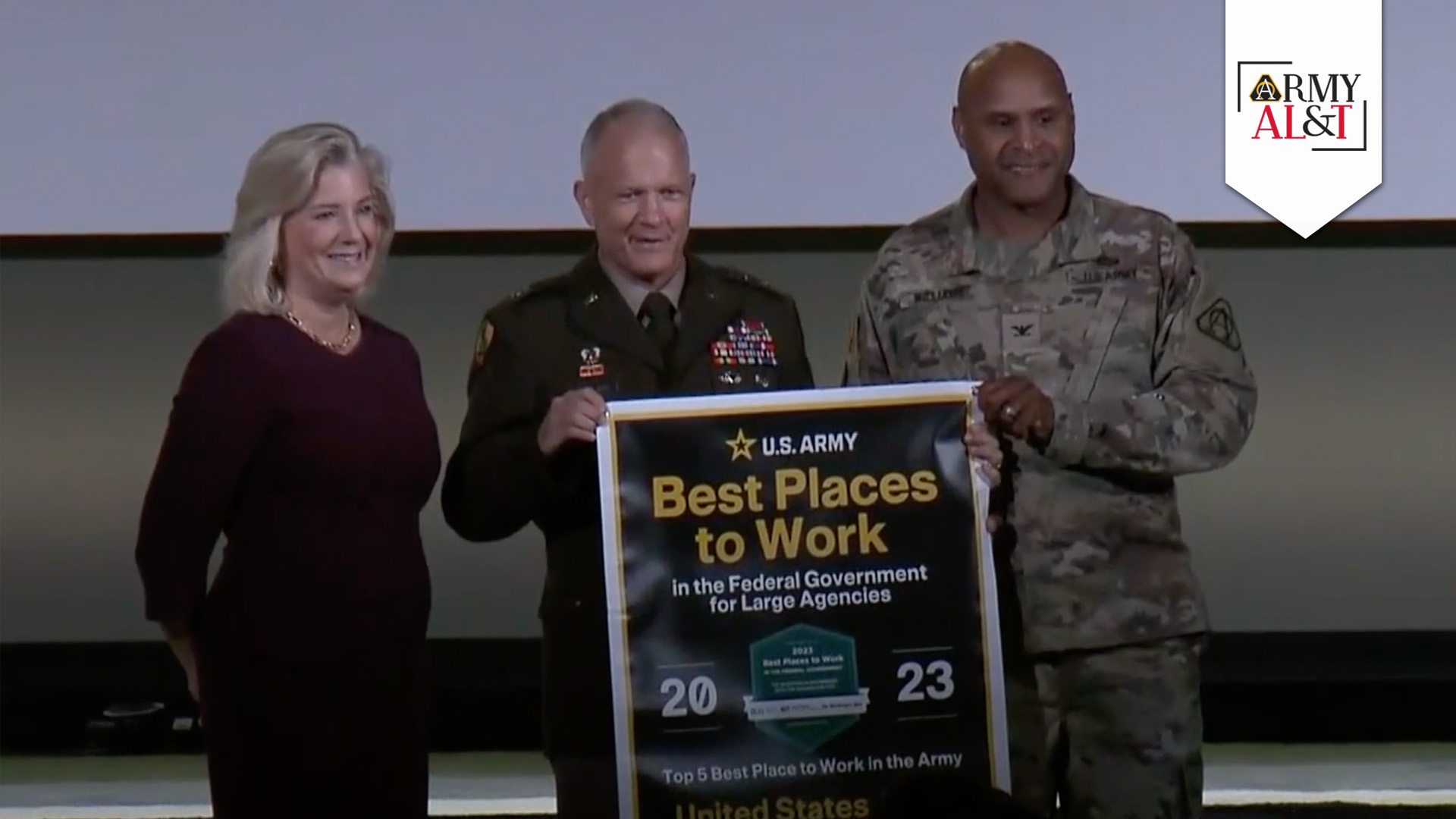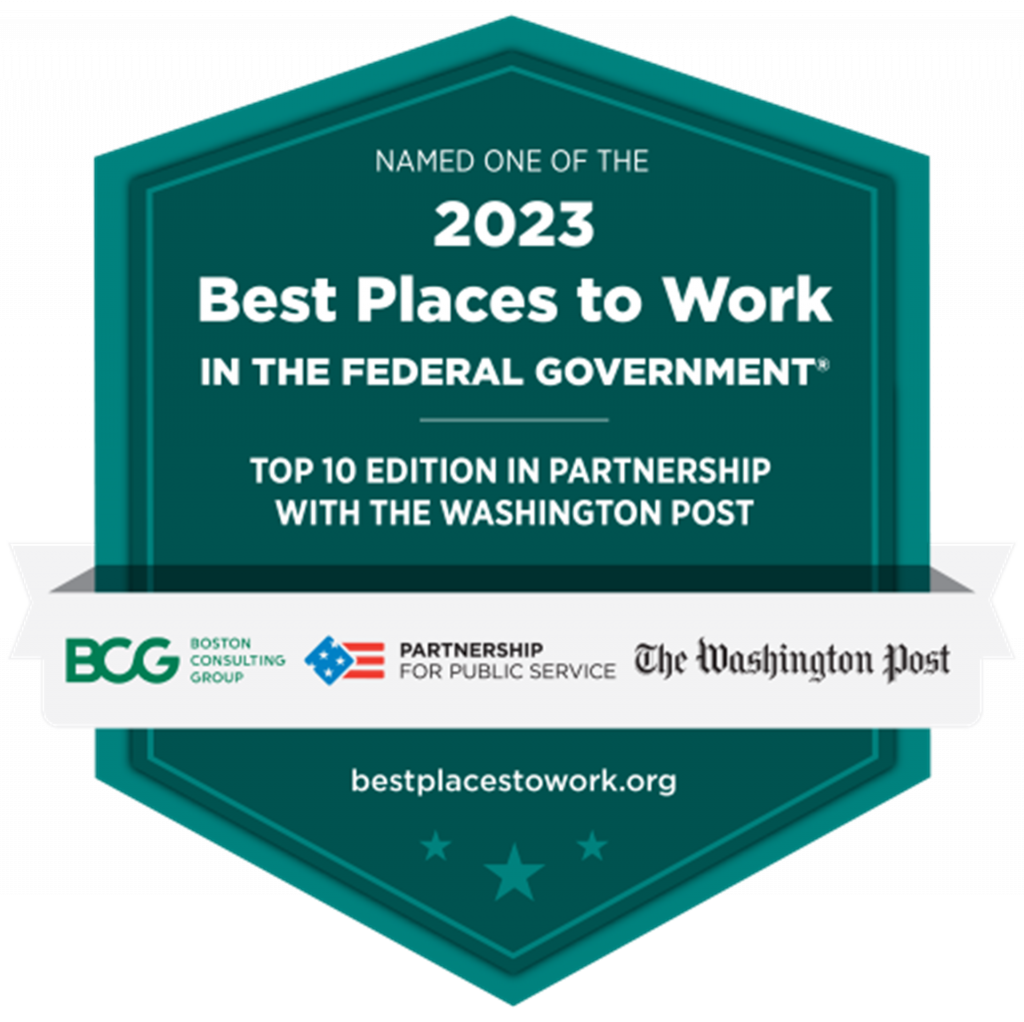
TOP 5 BANNER PRESENTATION: Secretary of the Army Christine Wormuth presented Best Places to Work banner to Lt. Gen. Robert M. Collins, military deputy director, ASA(ALT), middle, and Col. Barry Williams, deputy director, USAASC, at the Army Civilian Showcase portion of the 2024 AUSA Annual Meeting and Exposition on Oct. 16, 2024, in Washington. (Photo by Holly DeCarlo-White, USAASC)
USAASC is recognized as one of the ‘Top 5 Best Places to Work in the Army,’ reinforcing its commitment to acquisition excellence throughout its workforce.
by Cheryl Marino
The U.S. Army Acquisition Support Center (USAASC) has been recognized as one of the Top 5 Best Places to Work in the Army for 2023 by the Partnership for Public Service and Boston Consulting Group, reinforcing its dedication to acquisition excellence throughout its workforce—and driving home that its greatest asset is its people.
The USAASC provides training, education and career-development opportunities for professionals in the Army Acquisition Workforce to effectively support and equip the U.S. Army. As a direct reporting unit of the Assistant Secretary of the Army for Acquisition, Logistics, and Technology (ASA(ALT)), included in this recognition are the 12 USAASC-supported program executive offices (PEOs), which are responsible for the cost, schedule and performance of acquisition programs and portfolios.
“It is an honor that the USAASC is being recognized as a Top 5 Best Places to Work in the Army,” said USAASC Director Ronald R. Richardson, Jr. “The program executive offices have a big responsibility in managing a range of acquisition programs and portfolios. And our team at the USAASC headquarters supports the PEOs and the broader Army Acquisition Workforce by providing superior career development opportunities. These collective efforts enable Army modernization and continuous transformation, and I’m proud that our employees feel supported and empowered in their professional journeys.”

CIVILIAN SHOWCASE: Secretary of the Army Christine Wormuth, left, with Lt. Gen. Robert M. Collins, military deputy director, ASA(ALT), middle, and Col. Barry Williams, deputy director, USAASC, right, at the Civilian Showcase portion of the 2024 AUSA Annual Meeting and Exposition, on Oct. 16, 2024, in Washington. AUSA Army Civilian Advisory Committee Chairman, Bill Moore, far right, moderated the event. (Photo by USAASC)
MORE OF UPS
Secretary of the Army Christine Wormuth presented Col. Barry Williams, deputy director, USAASC and Lt. Gen. Robert M. Collins, military deputy ASA(ALT) and director of the Army Acquisition Corps—and leaders from the other top five Army organizations—with a banner for this achievement at the Army Civilian Showcase portion of the 2024 Association of the United States Army (AUSA) Annual Meeting and Exposition on Oct. 16, 2024, in Washington, D.C. The theme for this year’s Showcase was “Army Civilian Innovations and Changes that Keep Army Top 10 Best Places to Work,” where a panel of military and civilian leaders shared their expertise, insights and experiences with military personnel and fellow civilians, as well as industry and future talent.
“There is a sense of family,” Williams said of USAASC, after receiving the banner. “It was probably one of the only places that I’ve worked, for sure one of the few, with the amalgamation of great leadership and a great family atmosphere.” Every organization has its ups and downs, but he said in his experience at the support center there are more ups than downs. “It’s about teamwork and working together, and that’s why I’m honored to accept the award. We just have to keep it up and maintain it.”
MAKING THE CUT
In addition to USAASC, organizations ranking in the top five were Space and Missile Defense Command, U.S. Army North and 5th Army, Army Test and Evaluation Command and Headquarters Department of the Army Field Operating Agencies and Staff Support Agencies.
The AUSA Army Civilian Advisory Committee Chairman Bill Moore, who moderated the event, said making the list of best places to work in the federal government is a tribute to the senior leadership in the Army. “Leaders do three things: get missions done, prepare organizations for the future and most importantly, take care of their people,” he said. “And this is reflected in how the Army scored.”
Results were based on index scores from the Office of Personnel Management (OPM)’s annual Federal Employment Viewpoint Survey (FEVS), and calculated by the Partnership for Public Service and the Boston Consulting Group. The FEVS was designed to assess how employees jointly experience the policies, practices and procedures characteristic of their agency and its leadership, and then provide those results and indices across the federal government by agency size, and by agency, through its OPM FEVS dashboard.
The results offer insights into whether (and to what extent) workplace conditions characterizing successful organizations are present in federal agencies and provide information important to successful organizational change and development initiatives. USAASC’s overall index score has consistently increased over the last few years, making the organization one of the most desirable workplaces within the Department of the Army.
“If you give people the ability to do their job well, and give them the environment to do it, they are happier, and more effective,” said Frank Gonzalez, director and equal employment opportunity chief at USAASC’s Integrated Delivery of EEO and Accessibility (IDEA) Programs Office. “Great leaders are people focused, and people make the organization. The secret sauce for making the top five is simple,” he said. “Take care of your people. Make them happy and they stick around a while. They’re happy and it makes recruiting easy.”
Gonzalez explained that USAASC’s top five result was obtained by looking at the larger federal ranking system and breaking that down into sub agencies—large, medium, small and subcomponents—and their individual rankings. The Army as a large organization, has made the Top 10 Best Places to Work and USAASC, with 6,500 employees around the world, is considered a subcomponent and according to Gonzalez, “in the blue,” meaning above median. “We did well in several areas,” which, he said, translates to above average for the Army and above average for the federal government.
“Not only are we in the top 5 in the Army; we did even better than some NASA [National Aeronautics and Space Administration] organizations,” Gonzalez added that NASA has been the number one place to work in the federal government for 12 years in a row. So, he said, he’s happy with our progress so far.
“We [at the IDEA Office] take the results, evaluate them and do a deeper dive,” he said. “We look at the PEOs. Where can we move the needle to improve things? Now you’re doing great over here, but you seem to drop the ball down here. How do we improve communication? How do we improve collaboration? We’ve got all the data for the best places to work in the federal government so what we look at is actually part of a much bigger survey. We’re looking at all the aspects, not just how great of a place it is to work.”
Gonzalez said the FEVS was distributed to Army civilian employees (not military personnel or contractors); he’s hoping for a higher response in 2024, which would give his office more data to work with and a better idea how to improve things. “USAASC is a wonderful organization where people are engaged and dedicated to the mission. People like their jobs.” He said this is important since we (acquisitions) aren’t the point of the spear, we are the people who develop and purchase the spear. “Without the acquisition community there would be no weapons. There would be no equipment. There would be nothing for the people to use. Our organization, the PEOs, are the ones developing the next generation of all the equipment our folks are using.”

MAKING THE LIST: 2023 Best Places to Work in the Federal Government banner. (Graphic provided by USAASC)
CONCLUSION
Gonzalez said the IDEA office is currently working on another survey called the Defense Equal Opportunity Climate Survey, which includes all 6,500 USAASC employees—both military and civilian personnel. A comparison of both surveys will allow his office to figure out where the push point is if there is conflicting data. For example he said, “if both surveys say we need to improve [employee] recognition, we probably need to improve recognition. If one says recognition is great, and one says we need to improve it, well let’s see if it’s a civilian problem or military problem we need to dive into. The advantage of two different surveys really helps validate one another and we know if they both say it’s a problem, it’s a problem and we’re going to fix it.”
Historically, he said, USAASC does not have a high employment turnover. “People get promoted, people get selected for programs and move on to bigger and better things, but typically they do not leave for more money only a better situation. We’ve got some people that have been here for 30 to 40 years. They like the organization and that’s doing something right if they stick around.”
For more information go to https://asc.army.mil.
CHERYL MARINO provides contract support to the U.S. Army Acquisition Support Center at Fort Belvoir, Virginia, as a writer and editor for Army AL&T magazine and TMGL, LLC. Prior to USAASC, she served as a technical report editor at the Combat Capabilities Development Command Center at Picatinny Arsenal for five years. She holds a B.A. in communications from Seton Hall University and has more than 25 years of writing and editing experience in both the government and private sectors.







